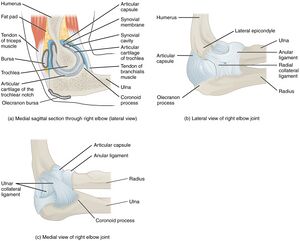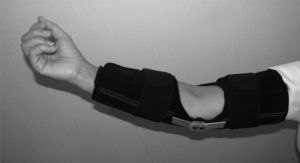Panner's Disease
Top Contributors - Chloe Waller, Shreya Pavaskar and Vidya Acharya
Introduction[edit | edit source]
Panner's disease is defined as an osteochondrosis of the humeral capitellum [1]. Patients aged 10 years and younger have lesions similar to those described by Dane Panner, without intra-articular loose bodies [2]. It is believed that Panner's disease predominantly occurs in boys because of the delayed appearance and maturation of the secondary growth centres.[3]Clinically Relevant Anatomy[edit | edit source]
The elbow joint is a synovial hinge joint. Three bones are involved in the articulation of the joint: the distal end of the humerus and proximal ends of the radius and ulna. The trochlea at the distal end of the humerus, projects anteriorly and inferiorly at an angle of 45°. The trochlea notch at the proximal ulna, projects anteriorly and superiorly at an angle of 45°. The orientation of these articular surfaces allows a large amount of flexion. It achieves this by delaying contact between the humerus and ulna and providing space for musculature.
Pathological Process[edit | edit source]
Abnormal valgus stress after the age of 5 years is the most important factor in the development of Panner's disease. The capitellum has a rich vascular supply prior to the age of 5 years. Afterwards, the nucleus of the capitellum is mainly supplied by posterior vessels functioning as end arteries. If those vessels are disrupted by repetitive stress (i.e. throwing), ischaemia can develop. This may result in the disordered endochondral ossification called Panner's disease[4].
Clinical Presentation[edit | edit source]
- a history of several weeks of pain
- stiffness in the elbow
- often with a history of valgus stress
- Aggravated with movement and relieved with rest
- effusion and swelling
- Limited range of motion is typically observed with approximately 20° of extension loss and, less commonly, loss of flexion. The duration of symptoms varied from a few months to 2 years.
- The subchondral vacuum phenomenon is a rare finding, but is highly specific to this condition. The vacuum phenomenon, which represents subchondral gas formation, is a sign of bone ischaemia and may indicate aseptic necrosis [5]
Diagnostic Procedures[edit | edit source]
Plain radiographs were used for diagnosing Panner's disease.
Initially the capitulum appears irregular with areas of radiolucency (indicating resorption), particularly adjacent to the articular surface, and sclerosis
- in 3-5 months, radiographs show larger radiolucent areas followed by reconstruction of the bony epiphysis;
- in 1 to 2 years, the epiphysis returns to its normal configuration with no flattening, presumably because the elbow is not weight bearing joint
- in about 50% of patients, adjacent radial head shows early maturation compared with the uninvolved elbow
A magnetic resonance imaging (MRI) scan may show more detail. The MRI can give a better view of bone irregularities and can detect effusion.
Outcome Measures[edit | edit source]
Management / Interventions[edit | edit source]
Symptomatic treatment for Panner's disease is sufficient because epiphysis becomes revascularized & develops normal configuration. Reducing elbow activities and avoiding straining activities can help with pain management and healing process. The use of a long arm splint for 3 to 4 weeks may be necessary until pain, swelling, and local tenderness subside. A cast was recommended for an inconsistent period of time ranging from 4 weeks to 11 months.[6]Non-steroidal anti-inflammatory drugs may be helpful.
It takes one to two years for the growth plate that makes up the capitellum to grow into solid bone. At this point, pain and symptoms usually go away completely. Treatments such as heat, cryotherapy, and ultrasound may be used to ease pain and swelling.
Differential Diagnosis[edit | edit source]
Resources[edit | edit source]
Panner's disease: Literature review and treatment recommendations
References[edit | edit source]
- ↑ Schumacher R, Müller U, Schuster W. Rare localisation of osteochondrosis juvenilis (author's transl). Der Radiologe. 1981 Apr 1;21(4):165-74.
- ↑ Ruch, DS , Poehling, GG . Arthroscopic treatment of Panner's disease. Clin Sports Med (1991); 10 (3): 629–636
- ↑ Claessen FM, Louwerens JK, Doornberg JN, van Dijk CN, Eygendaal D, van den Bekerom MP. Panner’s disease: literature review and treatment recommendations. Journal of children's orthopaedics. 2015 Feb 1;9(1):9-17.
- ↑ Claessen FM, Louwerens JK, Doornberg JN, van Dijk CN, Eygendaal D, van den Bekerom MP. Panner’s disease: literature review and treatment recommendations. Journal of children's orthopaedics. 2015 Feb 1;9(1):9-17.
- ↑ Anisau A, Posadzy M, Vanhoenacker F. Panner’s disease: The vacuum phenomenon revisited. Journal of the Belgian Society of Radiology. 2018;102(1).
- ↑ Claessen FM, Louwerens JK, Doornberg JN, van Dijk CN, Eygendaal D, van den Bekerom MP. Panner’s disease: literature review and treatment recommendations. Journal of children's orthopaedics. 2015 Feb 1;9(1):9-17.








